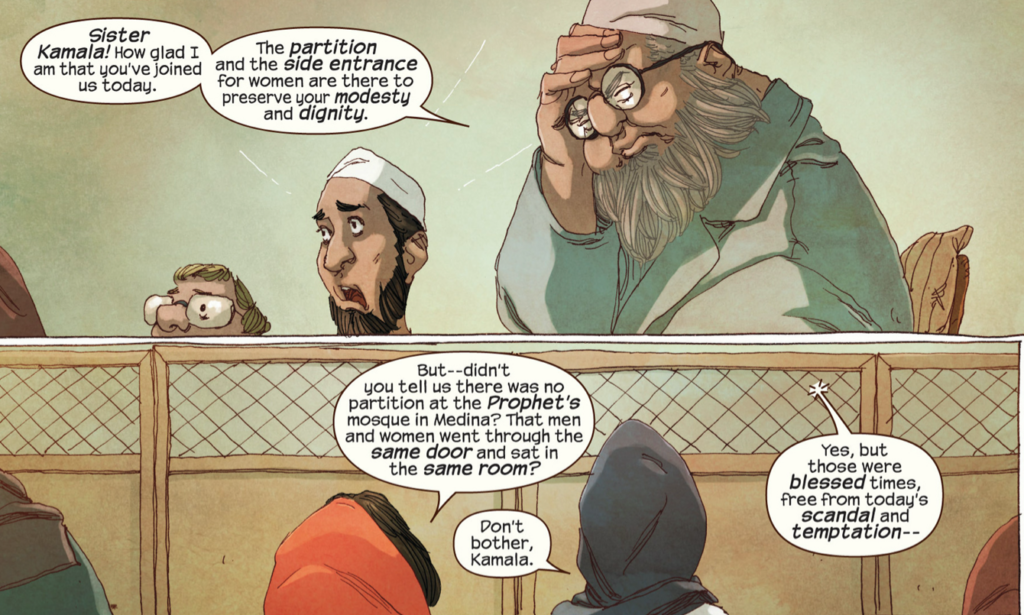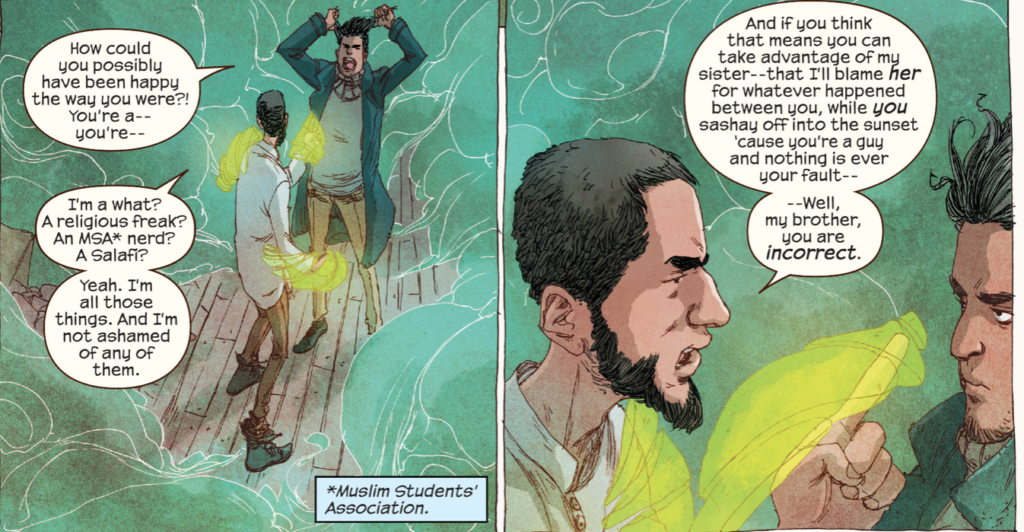Muslim representation in the media is on the rise, and comic books are no exception. Traditionally, the representation of Muslim women in comics has been caricatural at best, and offensively orientalist at worst.[1]Examples of orientalist female characters include “The Veil”, a villain introduced in the X-Men series in 1991; Nicieza, Fabian. “The Uncanny X-Men.” X-Men Annuals, 15th ed., vol. 1, Marvel … Continue reading The inaccurate and objectionable representation of Muslim women in pop culture follows the general trend of badly written female characters. This changed abruptly in 2014, with the introduction of the first female Muslim standalone superhero, Ms. Marvel, a 15-year-old Pakistani-American named Kamala Khan. Ms. Marvel reflects the general shift in comics of portraying empowered and independent female superheroes, revolutionizing the genre. So how exactly did Ms. Marvel deviate from the way Muslim women are represented in the media, and why is her character ground-breaking not just in the comic book industry, but also in pop culture in general?
Pop culture and mass media suffer from a common affliction, androcentrism, “the practice of placing male human beings or a masculine point of view at the center of our world, its culture, and our history.[2]https://www.merriam-webster.com/dictionary/androcentric” There is a popular phrase in the comic book world invented by writer Gail Simone, “the Women in Refrigerator Syndrome.” Simone coined the phrase on her now infamous website, where she curated a list of female characters who had fallen to this syndrome. The name is in reference to the 54th issue of Green Lantern (1994)in which Green Lantern comes home to find his girlfriend, Alex Dewitt, murdered and stuffed in the refrigerator. Her death serves as a plot tool to provoke Green Lantern into fighting the villain. This term very aptly recognizes that female characters are often victimized and used as plot devices to further the stories of men and to aid their heroic paths. The female characters are props to the male characters, existing only to stir up emotions of fury and revenge; the outdated, ‘woman dies, man learns something valuable’ trope. Exceptions to this depiction are rare.[3]Two notable female Muslim characters are Selma Tolon, a Turkish Red Cross doctor who helps people using her healing powers. Monica Chang, agent of S.H.I.E.L.D, is another Muslim character. Both had … Continue reading
Women aren’t just “put in refrigerators” in comic books, but in other forms of media as well. In television, Muslim women are often victims of society, fellow countrymen, or religion. They aren’t given agency of choice or the freedom to be anything other than the “Muslim character.” Their entire arc revolves around their identity as Muslims. Their humanity is stripped away as the women become the representation of an entire religion and carry the burdens of family, nation, and religion all in one. Repeat offenders are shows like Ramy, where the female characters in the show serve to aid Ramy’s path to piety; Élite, where the only visible Muslim, Nadia, is bullied incessantly for wearing a hijab and is protected by a white male character throughout the show in an attempt to humanize him. This raises an interesting question; in storytelling why does male maturation always come at the expense of female agency?
The marvel of Ms. Marvel is that its character does not fall into the cliché archetype traps that are set up for Muslim women in media. Kamala does not have the stereotypically antagonistic relationship with her family and her religion, nor does she carry the burden of assimilation. This is owing to the fact that Ms. Marvel’s creative team features two Muslim women, Sana Amanat, who is of Pakistani origin herself, and G.Willow Wilson. The diversity of the creative team is reflected in the storylines as Ms. Marvel breaks down the walls that are often built around female characters. Kamala, unlike many of her predecessors, is multi-dimensional, flawed, and as confused as any other 15-year-old American teenager. Her story is expertly told as we watch her navigate the world of herodom, fanfiction writing, attending high school parties, and exploring her relationship with Islam and her culture. The comic is filled with nuance and subtleties that only someone from the same culture could accurately capture and express. From a marketing perspective, Ms. Marvel reads like a PSA to hire more BIPOC writers to tell stories that they understand inside and out. Good and meaningful representation is the new gold rush. The wild success of movies like Black Panther has shown that there is big money to be made in diversity. It creates a trade-off between artists and big company execs, writers get to maintain their artistic integrity and tell stories that diverge from the white heteronormative templates; big studios can tap into an unexplored economic market. Additionally, Ms. Marvel is getting her own Hollywood treatment, with a live-action TV show set to come out in 2021. The normalcy and diversity of the various Muslim characters in Ms. Marvel is an excellent example of all that could be achieved when BIPOC are let into writers’ rooms.
Importantly, Kamala is never put in the refrigerator, nor are the supporting characters in her life. The characters are all unique individuals with their own plot lines. Her best friend Nakia is fiercely critical of capitalism and society. Subverting the clichéd narrative of the veiled Muslim woman as a victim, the reader finds out that Nakia’s father thinks her wearing the hijab is “just a phase.” Kamala’s mother and father are protective parents but are also given their own personalities beyond that. We see that her mother, Muneeba, is strongly adherent to Desi culture. She frequently speaks about the partition of India and Pakistan and her family’s experience, explaining the complexity of the issue to not just Kamala, but the audience as well.
Similarly, her father, Yusuf, isn’t the stereotypical, strict, immigrant father. He and Kamala share an affectionate relationship. In a particularly touching scene, we see Kamala struggle with her identity and is then comforted by her father, highlighting their close relationship.
Ms. Marvel also avoids cliché generalizations about Islam. In fact, the first run of the comic features discussions about Islam and culture that many in the Muslim community are well versed in: the space of women in mosques.

The nuanced representation of Muslims extends to other characters in the comic series. Traditionally religious conservative men are often portrayed in media as deeply misogynistic characters; men that fit this stereotype can be found littered in tv shows like Homeland, 24 and Chicago PD. Kamala’s brother, however, defies these stereotypes when he approaches a Muslim villain who tries to take advantage of his sister.

Moreover, religion isn’t something that defines Kamala, a litmus test that many female Muslim characters fail. As creator Amanat said, “As much as Islam is a part of Kamala’s identity, this [comic] book isn’t preaching about religion or the Islamic faith in particular. It’s about what happens when you struggle with the labels imposed on you, and how that forms your sense of self. It’s a struggle we’ve all faced in one form or another and isn’t just particular to Kamala because she’s Muslim. Her religion is just one aspect of the many ways she defines herself.”[4]Wheeler, Andrew. “All-New Marvel NOW! Q&A: Ms. Marvel.” Wayback Machine, November 6, 2013. … Continue reading

As media continues to evolve to incorporate different narratives and storytelling, we can only hope that fewer women are stuffed in refrigerators, and instead are given fulfilling character arcs. Ms. Marvel serves as a model of what good representation looks like. Although this comic series isn’t free of its own issues,[5]Soule, Charles. Gwenpool Holiday Special. 1. Vol. 1. Marvel, 2015. The Christmas Issue of Ms. Marvel fails to identify and acknowledge the existence of Black Muslims as Kamala incorrectly conflates … Continue reading it is an incredible and promising start in the world of Muslim characters. As Simone says, “None of us are alike in real life, so why should they all be alike in fiction?”[6]Abad-Santos, Alex. “How Gail Simone Changed the Way We Think about Female Superheroes.” Vox. Vox, October 17, 2014. … Continue reading
Notes / References[+]
| ↑1 | Examples of orientalist female characters include “The Veil”, a villain introduced in the X-Men series in 1991; Nicieza, Fabian. “The Uncanny X-Men.” X-Men Annuals, 15th ed., vol. 1, Marvel Comic, 1991. The Veilis a nameless, faceless character, personified as Iran’s chemical weapons program (her superpower is producing poisonous gas). Another example is Sooraya Qadir, found in X-Men 2002. She is a hero from Afghanistan, but is shown speaking only in Arabic, and wears a niqab and burqa style that is not native to Afghanistan. |
| ↑2 | https://www.merriam-webster.com/dictionary/androcentric |
| ↑3 | Two notable female Muslim characters are Selma Tolon, a Turkish Red Cross doctor who helps people using her healing powers. Monica Chang, agent of S.H.I.E.L.D, is another Muslim character. Both had satisfactory character arcs that did not revolve around their Muslim identities. However, these women did not get their own comic books, rather they served as supporting characters. |
| ↑4 | Wheeler, Andrew. “All-New Marvel NOW! Q&A: Ms. Marvel.” Wayback Machine, November 6, 2013. https://web.archive.org/web/20131107052245/http://marvel.com/news/story/21466/all-new_marvel_now_qa_ms_marvel. |
| ↑5 | Soule, Charles. Gwenpool Holiday Special. 1. Vol. 1. Marvel, 2015. The Christmas Issue of Ms. Marvel fails to identify and acknowledge the existence of Black Muslims as Kamala incorrectly conflates the Black experience with the Muslim Experience. Although in later issues Kamala’s brother becomes engaged to Tyesha Hillman, a Black convert. This specific comic arc addresses anti-blackness within the Muslim Community. |
| ↑6 | Abad-Santos, Alex. “How Gail Simone Changed the Way We Think about Female Superheroes.” Vox. Vox, October 17, 2014. https://www.vox.com/2014/10/17/6981457/gail-simone-dc-comics-female-superheroes. |




